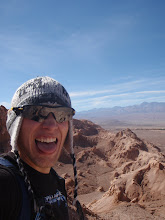I groan as I break over the pass shrouding an alpine gem known as Iceberg Lake. I look back at my partner, Ian just down the hill from me making his way up in a steady manner. We're breathing hard despite what little hiking we've done so far this morning. Slowly, we plod to a rock to escape a frozen breeze sweeping the snow-covered lake. It's a moment before we speak to one another; our minds in that oxygen-starved doldrum between focus and blasé concern. Motivation and logic are hard to come by here, movement is sluggish and weak at times. We wearily look at the looming face of Whitney with hypoxic awe as my partner announces he has forgotten his helmet back at camp...
It took only 3 and a quarter hours last night to get to our high camp at 12,300. When you come from Reno at 4400 feet and make it up that high, that fast... You're gunna feel it. Usually.
No one knows exactly what causes altitude-related illnesses such as AMS (Acute Mountain Sickness) HAPE (High Altitude Pulmonary Edema) or HACE (High Altitude Cerebral Edema) but it's no joke. Look at the death earlier this month on Mount Shasta: accomplished climber, vibrant, young and healthy. Falls over while he's putting on his crampons (traction spikes for your boots) and remains unresponsive. Found a couple days later dead, stuffed in a snow cave.
Read more about it here:
Another good example regarding the ghastly reaches of altitude sickness takes us back to 1953 as a group of visionary mountaineers found themselves in a desperate situation at 25,500 feet (makes my altitude threshold look pathetic) on the infamous mountain: K2. Storm-bound, mountaineer Art Gilkey developed clots in his legs (easy to do in thick, oxygen-depleted blood) and required immediate assistance in descending the mountain. Incapacitated, the team wrapped him in a sleeping bag and together, slowly belayed him down the savage mountain. Suddenly, the lead downclimber lost his footing, ripping each person above him off their feet.
Death was certain. Bound by rope, all of the team raced down the impossibly steep South Face- save for one man, Pete Schoening, who was able to arrest the fate of the entire team through sheer strength and skill via an ice axe-hip belay.
This is known in mountaineering history as "The Belay."
Gilkey was swept away by an avalanche moments after the heroic save. He was discovered in 1993 as the Godwin-Austin Glacier was melting out.
The next morning, after deciding against a late start on the route, I wake up coughing. Blood and pink frothy crap make my spit colourful enough to warrant a longer stay in the tent. Ian rushed up to our gear cache at the toe of the buttress (the guy's carved out of steel, or some lightweight carbon-fiber material I swear) as I shivered out my affliction within the relative safety of my floorless tent. When he returns, I know that I am deteriorating and that i must descend. I am also thankful to have a strong partner as his willingness and ability to retrieve the gear means that the ropes and protection amounting to my life savings is secured.
As we head down, I am overcome with waves of nauseousness that test the reserves of my digestive system. I am weak and I slip several times trying to negotiate the wind-packed snow.
We stop at a lower alpine lake about 2,500 feet lower and I am finally hungry and thirsty enough to pull out a GU packet from my pocket. There is an enormous igloo that someone made near us, blue ice cascades off the North Wall of the pass we just descended. The lake, called Lower Boy Scout, is exposed from the snow and placid waters fracture beautifully underneath the gray skies that loom overhead. My hunger broods as Ian produces some fresh jack cheese he's been carrying and offers to share. We share laughs, destroy cheese and talk about how unused food (particularly heavy food items like cheese) carries "potential energy."
A thousand feet lower and my coughing fits have ceased, save for the occasional bad joke or wag-bag comment. My nausea is no more and I am thankful to be on dirt again, moving fast through the glacially-fed forest.
I spoke with my mom the next day- today, actually, between shifts at work. After a hefty scolding, I tell her that I am 23, 6 feet tall and bulletproof. She dismantles me quickly however, and reminds me that I am not in fact 23, but 22.. That I am not quite six feet tall but 5'11". This leaves the "bulletproof" sections about as suspect as two college students eating salads out on a Winco bench at Northtowne.









It scares me you got so sick, but I'm glad you're feeling better now :-)
ReplyDelete